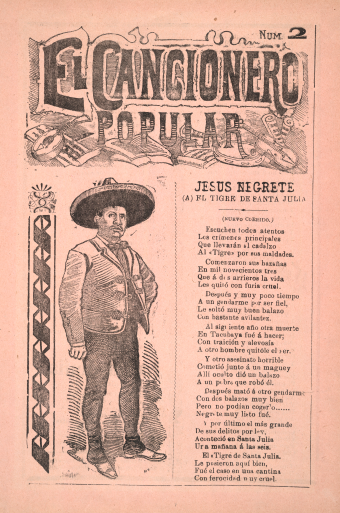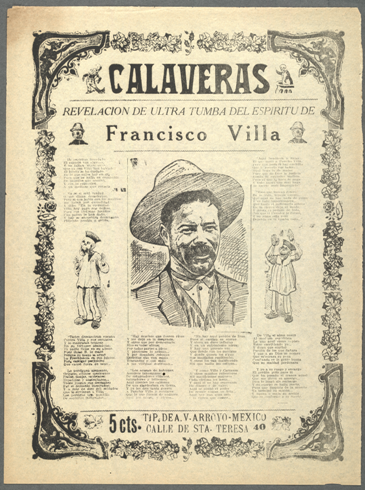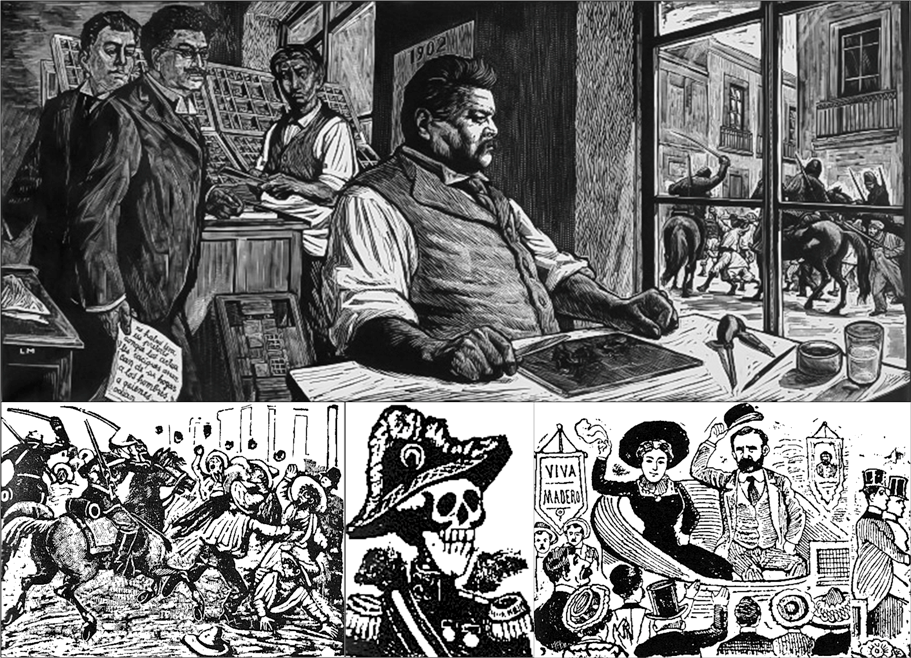José Guadalupe Posada the illustrator of ballads was the prophet of two revolutions, both of them violent. One was the armed mass uprising generally dated 1910-1921, from the fall of Diaz to the presidency of Obregon. When a Mexican speaks of “the revolution” he refers to this period, but more often, unless he is speaking of a particular event, to the ideology developed during and after this warring. Concretely, the revolution as yet has made no great changes in the social organization and the private welfares of most Mexican citizenry—largely still the contrary. It has, however, changed the public mind.
Revolution in Mexico now means loyalty to native values; means an attitude of facing mucky political and social messes and cleaning them radically; means mental honesty; and the highest respect for work. The cornerstone and yardstick of national value is the native: the peasant, the laborer. Your true revolutionary is likely to clasp more fervently than necessary, the heretofore “degenerate and ridiculous” peasant to his heart; and to kick spectacularly, foreign art, foreign systems, foreign images, into the Gulf or the muddy Rio Grande. “Imposition” —in the Mexican sense absentee landlordship of everything including land—is the factual and ideological heart of the heaped resentments which brought on revolution. The new social religion is a burning anxiety in Mexico to be true to herself.
Related → Emiliano Zapata: In the name of the land
The artistic expression of this national feeling occurred before, after, and simultaneously with, the armed expression. Guadalupe Posada foretold, in pictures, the ten years’ travail he did not witness; and the translation thereafter, in pure artist’s values; the travail which bore the new Mexican image in painting, music, literature. Which bears a new philosophy, a new aesthetic, a living and great national art.
Guadalupe Posada was born in León, Guanajuato*, in 1864, like most of the great men of Mexico from a middle-class, provincial family. Leon is a simple old town center of roads from great mines; Guanajuato is a sage-green and gray-brown state tufted and terraced and tunneled, of surface usually sparse. The landscape and the life of the people is biblical. *[Editor’s note: Posada was actually born in the state of Aguascalientes on February 2, 1952]
A flood famous in ballads in the year 1888 set young Posada to thinking about other places than Leon, and he went to the capital to seek his fortune, he said. Don Antonio Vanegas Arroyo, founder of the best-known publishing house in Mexico, employed him as illustrator. The house of Vanegas Arroyo was not a business organization. It was a family. The children played with old cliches and learned to rhyme when they learned to read, and inherited the enterprise. Though revolutionary looters crashed most of the presses, and though vindictive bureaucrats later, accusing the house of pro-Church sentiments, committed therein vandalism, the children and grandchildren of the house of Vanegas Arroyo still edit its street-gazettes and print its hymns, plays, ballads and tales, tending its presses as if they were ancestral fields.

The eldest son of Don Antonio went mad when the presses were broken by government explosives. Don Blas, a middle son, is now the manager and editorial policy of the house. His mother, the wife of the founder, tends the expendio, the retail shop. She sits crocheting among stacks of leaflets and leather-bound prayer books, and gossips of current and past events with the fruitmen, the flowerwomen, and the occasionally slightly drunk troubadours who drop in to tell or hear the usual latest, sometimes in verse. These latest are still illustrated by Posada, though he died nearly ten years ago (in 1913). The cuts are sturdy enough for many re-printings, and as current events and personages resemble past, appropriate in subject.
Don Blas remembers Posada as an amiable man, already bald, with a fringe of white hair around his smooth dark skull. “He was very industrious. He began to work at eight o’clock in the morning and worked until seven at night. My father would enter the shop (we set up a shop for him after he had worked a while with us) with whatever he wanted to print, and say, ‘Señor Posada, let’s illustrate this’, and Posada would read it and while he was reading would pick up his pen and say, ‘What do you think about this little paragraph’, and he would dip his pen into the special ink he used and then give the plate an acid bath and it was finished. He got three pesos a day whatever he did, and in that time it was a lot because whoever had as much as seventy-five pesos a month was at least a general. Posada was very good-humored and peace-loving. He hated quarrels, and treated everybody well. He was no snob.
“One thing about him only, I suppose, could be considered a little out of the ordinary and this was that he liked to drink, but in a very special way. He saved all year, fifty cents a day, putting it in a little box. On the twentieth of December he broke the bank and sent the money to Leon, to his family, and they bought for him with it big barrels of tequila, high as your waist. Then on New Year’s Eve he began to drink, alone, and drank and drank till he finished all the barrels, which took from a month to a month and a half. For a fortnight after he couldn’t work, because his hands shook. He was slender as a young man but from drinking like that he grew very large in the stomach… And eight or a hundred litres of tequila a year finally killed him.”
The Mexican corrido and Posada
II
In the house of Vanegas Arroyo the Spanish romance emerges as a Mexican corrido, and the woodcuts and prints which accompany it change from medieval, comparable to Spanish, French, German and British popular engraving, to modern Mexican. Manuel Manilla, Posada’s predecessor, was an excellent craftsman who followed the colonial style developed directly from Spanish engravings. Manilla is romantic, has the simplicity of total acceptance, as well of text as of traditional attitude to the text, spiritual and artistic.
Posada created his own tradition, beginning with the mechanics of his art. He invented a technique of drawing in acid directly on zinc plates, departing thus from the older wood or zinc cut. His engravings are not examples of mass art. They establish him as a personal, highly competent, completely conscious and fully adequate master. There is the same distance attitude which determined his position, his occupation, the choice of his subjects and the manner of portrayal; which links him with the revolution by mob, and the revolution on painted walls. Posada worked in the period just before the revolution; in the air of Mexico’s age of gilt. Official Mexico was affectedly French, foreign. It had a strong hangover of bibelot from the time of Maximilian, a taste for landscape from rationalist France, and an idea four centuries old that mentally and spiritually, the “decent” people, the upper minority, must belong to Europe. Mexico was loot. To Europe must be looked for culture.
This gilded age marks the ultimate divergence between native and white, between the culture of the people, in the medieval sense of that class, and the culture of the elite. The official artists of the period, who have sunk to the anonymity Posada espoused, were fin de siecle. Their patrons were formal bearded portly old gentlemen and large-volumed ladies bound in black (as if mourning in advance the bitter days to come) who lived among spindle-legged chairs, mirrors, and lace to grotesquerie. And who lived idly in euphemy.
To have taken much notice of ballads or their illustrations would in the gilded age have been considered a suspicious and at all events a ridiculous proceeding. These belonged in the servants’ quarters. Posada chose, therefore, instead of immediate applause, to be unknown, widely distributed, and much enjoyed; to be also useful. Perhaps in conversations with Don Antonio Vanegas Arroyo; perhaps only in his own mind, Posada drew significant and thoughtful commentary on the events of the time: protested, foreboded, and with a full heart scribbled on a corner of the national slate a mene, mene, tekel upharsin. He turns an obsidian mirror upon the land and makes a choice, deliberate image.
Manilla’s illustrations for prayers, or for ballads such as that of the unfortunate Juan who for stealing the jewel of a saint was snatched to hell, show the artist’s explicit and calm belief in the form and manner of the saint, in the form and nature of the demon, in the procedure of snatching. Posada’s fiends are extremely fiendish, caricatures, mockery. Manilla’s women are peasant women, arcadian, idyllic; Posada’s are portraits, women of tragedy. Portrait of the national panorama carries conviction enough, when it is conscious portrait, and establishes the inevitable social outcome. A peasant family on the march, to exile and in slavery; a patient crowd, restless a little in time of hunger, women holding their empty baskets; the plague, and people shoveled dead into carts, mounded. He garbs the dictator and his cabinet in the skull and skeleton of national carnival. He makes Federal policemen and soldiers effeminate. Blandly he pictures an aristocrat’s ball (an event of the time), as a dance of perverts.

Chronologically last Posada chooses from Vanegas Arroyo’s “Street Gazette” (leaflets recording usually miracles and remarkable crimes) strikes, mobs, anti-Diaz meetings, dispersed by the buckled and sworded police. Madero enters the capital and Posada makes him bow and smile like a puppet. In the earthquake which heralds his entrance at dawn on the day of the parade, Posada symmetrically crashes the Mexican world into shards. When the metropolitan press later describes Zapata as a bloody, pernicious and monstrous “Attila of the South” (about fifty miles south) and pictures Villa, echoing American reporters as a kind of genial Robin Hood, Posada makes Villa plumply ambitious; of Zapata he builds somber grandeur.
Posada, prophet of shift in the national scene which comes with the Revolution
By implication not evident in the text he was illustrating; by interpretation grown of conviction; because of his shafted laughter; because of enormous pity and tranquil clairvoyance, Posada is the prophet of that sudden shift in the national scene which comes with the revolution. There is a different reliance on miracles. Hope walks out of its mystic garments and girdles itself with bullets.
Guadalupe Posada the illustrator of ballads was smilingly aware of the genteel National Academy of Arts around the corner from his hole-in-the-wall workshop. Possibly he used its excellent library. Doubtless he occasionally nodded to a couple of restive youngsters who, on their way back from the pedagogues, elbowed each other in front of his window (as after on mural scaffolds), and cut off some of his light. Orozco and Rivera both were impressed by one thing in that window besides the artist himself. This was a very fine print of Michael Angelo’s Last Judgment.
III
The first revolutionary songs that Posada illustrated were ballads of love and exile, and prophetic lyrics like this:
Suppose we were chaff, that was lying about When a very small whirlwind brushed us to the sky, And then at the moment when we sailed highest, A wind that was stronger blew us apart…
Of ballads, Posada illustrated two classics, the prisoner and the soldier. These lovely things ache still in every singing voice of the land. They are very old. They span revolutionary history, and make it. The prisoner is “The Prisoner of San Juan de Ulua”, a fortress built down into the waters of the Gulf of Mexico just off the coast of Veracruz. Here Diaz buried conscientious objectors. In a ballad-picture, one of them jumps off the parapet into the bellies of sharks below. The chant says in part:
I am imprisoned behind the bars
A prisoner I must remain;
I cannot weep, and from my heart
I sing my sadness and my pain.
In the morning I was taken
They sat me on a bench;
By the judge’s verdict, deliberate
Guilty to prison I was sentenced.
It is no longer the boat or sail
That waits for me on the open waves,
In San Juan de Ulua, the terrible jail,
I’ll end my sorrows and my days.
The ballad of the soldier is the story of a Federal, one of the Diaz army. Any one.
At the age of fifteen,
Pressed into service
I was made a soldier
Of the fifteenth of Puebla.
I followed the profession
Happy and content
When some time had passed
They made me a sergeant.
Then I did not like
Fighting any more,
So I deserted
And went back home.
I was in my house,
With my poor mother,
When the patrol
Came sword in hand for me.
Señores, señores,
How do I harm you?
You rascal, you scoundrel
Deserted from the army.
Now they are taking him
To the colonel for trial
And his poor mother
Follows him crying.
Now they are dragging him
There by the hands,
And they burst fountains
Oh, blood of his veins!
Goodbye my old quarters
With its many doors,
Goodbye my lieutenant
And my corporal Dolores.
Be careful, be careful
Soldiers and drummers
He goes out tomorrow
To be shot with the others.
Goodbye little brothers,
Dear parents, farewell
Here my sins end,
I have no more to tell.
Posada dies three years into the Mexican Revolution
When the Mexican revolution was an act; when Madero, refused sanctuary in the American Embassy, had been shot by people who next Easter appeared in effigy on telephone posts; and Villa filled the foreign press and his leather breeches with the figure of the Mexican Bad Man, Posada died. He had caught up the past and etched it to the future in hundreds of dramatic little pictures permanent till dust and the ink of many re-printings erase them. He had sketched in two inches monumental figures, national epics, that later grew to ten and fifteen feet high on frescoed walls. His women are the rearguard of gunned pilgrims thereafter; and the madonnas, the sweethearts, whose wooings became marching songs. Thus Adelita, the Villa musical herald, sung always with spatter of bullets and whoops at the end of each stanza:
Adelita is the name of a maiden
Whom I love though we be so far apart,
She’s a rose growing somewhere in a garden,
That some day I will pin on my heart.
If Adelita went off with another,
Ceaseless her road I would gain,
If by sea in a warship I’d follow,
If by land in a military train.
Adelita is a girl of the border,
Green as the sea are her eyes,
The soldiers all dream about her,
Every one of them for Adelita cries.
Oh, the bugle that calls us to battle,
And the bugle that calls us to review
In my soul echoes always your name only,
Adelita my heart longs for you.
If some day I am killed in a battle,
If my body on the sierra is to lie,
Adelita, if God will allow it,
To the sierra you shall go and cry.
And thus Valentina, the Zapata shriek, sung by Indians disappeared under great sombreros or in the cracks of the hills, on horseback:
Valentina, Valentina,
Valentina I must say,
I am driven by a passion,
That is what brings me today.
Because of this love, they have told me
I’ll suffer and pay, and pay
Who cares, if it was the devil
I’ll be killed in my own way.
If now I’m drinking tequila,
Tomorrow I guzzle fine wine,
Because today I’m a poor man,
Tomorrow I shall be gone.
Valentina, Valentina,
Listen to what I shall say,
If I’m to be dead tomorrow
Let them kill me right away…!
Biography of José Guadalupe Posada
© 2015 - 2024, Anita Brenner. All rights reserved.





